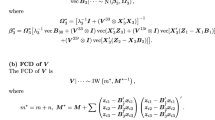Abstract
This paper formulates a model for the allocation of total weekly discretionary time of individuals between in-home and out- of-home locations and between weekdays and the weekend. The model formulation takes the form of a continuous utility-maximizing resource allocation problem. The formulation is applied to an empirical analysis using data drawn from a 1985 time-use survey conducted in the Netherlands. This survey gathered time-use information from individuals over a period of one week and also collected detailed household-personal socio-demographic data. The empirical analysis uses household socio-demographics, individual socio-demographics, and work-related characteristics as the explanatory variables. Among the explanatory variables, age of the individual and work duration during the weekdays appear to be the most important determinants of discretionary time allocation.
Similar content being viewed by others
References
Allaman PM, Tardiff TJ & Dunbar FC (1982) New approaches to understanding travel behavior, NCHRP Report, 250, Transportation Research Board, Washington, DC.
Andorka R., Harcsa I & Niemi I (1983) Use of time in Hungary and in Finland: comparison of results of time budget surveys by the Central Statistical Offices of Finland and Hungary, Central Statistical Office of Finland, Helsinki, Tutkimuksia Undersokningar Studies.
Axhausen K & Gärling T (1992) Activity-based approaches to travel analysis: conceptual frameworks, models and research problems. Transport Reviews 12: 324–341.
Bhat CR (1998) A model of post-home arrival activity participation behavior. Transportation Research, Part B (forthcoming).
Bhat CR & Koppelman FS (1993) A conceptual framework of individual activity program generation. Transportation Research 27A(6): 433–446.
Brog W & Erl E (1981). Application of a model of individual behavior to explain household activity patterns in an urban area to forecast behavioral changes. In: International Conference on Travel Demand Analysis: Activity Based and Other New Approaches. London: Oxford University Press.
Chapin FS & Hightower HC (1966) Household activity systems – a pilot investigation, monograph, Center for Urban and Regional Studies, Chapel Hill: University of North Carolina.
Chapin FS (1974) Human Activity Patterns in the City. New York: John Wiley & Sons.
Cullen I & Godson V (1975) Urban networks: the structure of activity patterns. Progress in Planning 4: 1–96.
Ferguson D & Jones PM (1990) HATS study of wheelchair disability in Adelaide, Report to the Director General of Transport, South Australia.
Greene WH (1990) econometric Analysis. New York: MacMillan Publishing Company.
Hägerstrand T (1970). What about people in regional science? Papers and Proceedings of the Regional Science Association 24: 7–24.
Harvey AS & Elliott DH (1983) Time and time again: explorations in time use, Explorations in time use series, 4, Ottawa.
Harvey AS & Gromo S (1986) Social contact and use of time in Canada and Norway: a comparative analysis of time use patterns. In: Aas D, Harvey AS, Wunlipinski E & Niemi I eds Time Use Studies: Dimensions and Applications. Helsinki: Central Statistical Office of Finland.
Harvey AS, Szalai A, Elliott DH, Stone PJ & Clark SM (1984) Time Budget Research: An ISSC Workbook in Comparative Analysis, Frankfurt: Campus Verlag.
Jones PM, Koppelman FS & Orfeuil JP (1993) Activity analysis: state of the art and future directions. In: Developments in Dynamic and Activity-Based Approaches to Travel Analysis (pp 34–55). Aldershot, England: Gower.
Juster FT (1985) A note on recent changes in time use. In: Juster FT & Stafford FP eds Time, Goods, and Well-Being (pp 313–332). University of Michigan, Survey Research Center, Institute for Social Research, Ann Arbor.
Kitamura R (1984) A model of daily time allocation to discretionary out-of-home activities and trips. Transportation Research 18B: 255–266.
Kitamura R (1988) An evaluation of activity-based travel analysis: a review paper. Transportation 15: 9–60.
Kitamura R, Yamamoto T, Fujii S & Sampath S (1996) A discrete-continuous analysis of time allocation to two types of discretionary activities which accounts for unobserved heterogeneity. In: Lesort JB (ed) Transportation and Traffic Theory (pp 431–453). Oxford: Elsevier.
Kraan M (1996) Time to travel?; a model for the allocation of time and money, Unpublished PhD dissertation, Department of Civil Engineering, The Netherlands: University of Twente.
Lingsom S & Ellingsaeter AL (1983) Work, leisure and time spent with others: changes in time use in the 70s. In: Statistiske Analyser. Kongsvinger, Statistisk Sentralbyra, Oslo.
Pas EI & Harvey AS (1997) Time use research and travel demand analysis and modeling. In: Stopher P & Lee-Gosselin M eds Understanding Travel Behavior in an Era of Change (pp 315–338). Oxford: Elsevier Science Ltd.
Reichman S (1976) Travel adjustments and life styles: a behavioral approach. In: Stopher P & Meyburg A eds Behavioral Travel Demand Models. Lexington, Massachusetts: Lexington Books.
Scanzoni J & Szinovacz M (1980). Family Decision-Making: A Developmental Sex-Role Model. Beverly Hills, CA: Sage Publications.
Szalai A (1972) The Use of Time. The Hague: Mouton.
Wissen L van (1989) A dynamic model of household interactions in activity patterns, presented at the International Conference on Dynamic Travel Behavior Analysis, Kyoto, July.
Author information
Authors and Affiliations
Rights and permissions
About this article
Cite this article
Bhat, C.R., Misra, R. Discretionary activity time allocation of individuals between in-home and out-of-home and between weekdays and weekends. Transportation 26, 193–229 (1999). https://doi.org/10.1023/A:1005192230485
Issue Date:
DOI: https://doi.org/10.1023/A:1005192230485




